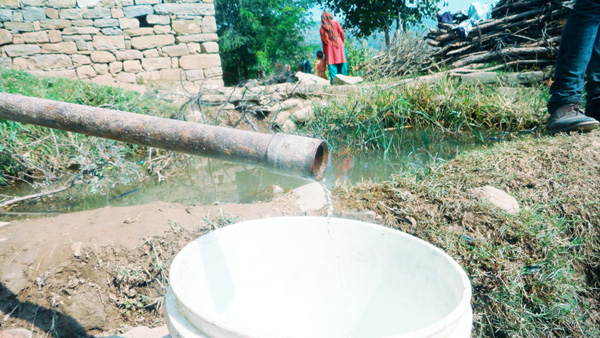Iram Farooque
One of the biggest electoral promises of the AAP Government in Delhi, 666 liters of free water supply every day to each household with functional water meters, sounds surreal to sixty-five year old Maqsooda hailing from the remote Balakote village in Poonch District, who has, for most of her life, travelled a minimum of two to three kilometers twice a day to fetch drinking water for her family.
“We definitely do have issues with the challenges of living in this international border area, but that we have accepted as our misfortune. Our main concern really is the availability of safe drinking water,” rues Maqsooda, highlighting how the Government has shown virtually no concern towards the people who live in this high-risk part of India, along the volatile Pakistan border.
The Balakote Block where Maqsooda lives has often been in news, unfortunately for all the wrong reasons. Its close proximity to the Line of Control (LoC) described by the locals as “the fence” has been a cause of mental and physical distress to the villagers for years. Things got worse last year when there were 150 cases of cross-border firing reported -the highest in the last eight years. Despite being the first ones to protect the border, the development challenges of these destitute villagers have been addressed with gross insensitivity. Be it electricity, roads, safe drinking water, education or employment – every issue that plays an important role in shaping the life of an individual is being neglected in this border village.
Due to security reasons, villagers who have been issued identity cards by the security forces are allowed to have a restricted movement only during the day and only after strict security checks each time they cross the gate. To attend school, visit the market, makephone calls – their every basic necessity involves a struggle; a struggle understood only by the people involved. Everything else, the villagers feel, can be dealt with but unavailability of safe drinking water in the village worries them the most.
“Our village has no facility for safe drinking water. We have to travel about four kilometers every day to fetch water. There are no water pipes, no tanks. We have no option,” shares thirty-five year old Shameem. The problem intensifies during social functions, marriages or deaths in the village. These are the occasions when the locals require ample quantities of water which, unfortunately, simply isn’t available.
The state of Jammu and Kashmir located in the Great Himalayas, is bestowed with scores of natural water resources, which undoubtedly have shrunk over the years but are more than sufficient to fulfill the needs of its people if used wisely. There are small springs locally known as cheshmah at a distance of every few kilometers, from where villagers fetch water. In winter, water is available every 2-3 kilometers but the larger problem is during summer when not every cheshmah offers water. “During Summer, we have to walk many miles to collect water, balance the buckets on our head and walk back to our village on this hilly terrain lacking roads,” Shameena explains.
This entire struggle to get the few buckets of potable water creates a huge distrust towards the Government, which is seen to have done absolutely nothing to solve the problem of the villagers. The anguish is apparent in sixty-five year old Bilquees’s reaction, upset as she is with the fact that fetching water from long distances is affecting the health of her daughter-in-law. “What can we do? We are as much a part of India as a person sitting in Delhi is. We also need safe drinking water. Why, then, is our Government not keen on helping us?” asks Bilquees.
However, in the troubled times, a little help comes from the armed forces that supplies drinking water to the villagers that fulfils the urgent requirements.
Last year, a report published in a State Daily claimed that only 34.7 percent of the population in Jammu and Kashmir has access to safe drinking water through taps, while the remaining 65.3 percent use water from unprotected and untreated sources, hand-pumps, rivers, canals, ponds and springs.
According to sources “Under National Rural Drinking Water Programme (NRDWP), the government has to provide safe drinking water to uncovered, partially covered areas, increase water quality, cover of rural schools, improve sustainability of sources and systems, besides streamline the operation and ensure maintenance of schemes.”
The report also highlighted the last official figures – out of 14,028 habitations targeted to be covered under NRDWP, only 8525 have been provided safe drinking water in last four years while 5504 habitations are still deprived of safe drinking water. Not much has changed in the last one year putting villagers in a dilemma as to which challenge they should fight first – fighting the shelling from across the border or the one with its own Government.
(Charkha Features)
Trending Now
E-Paper


